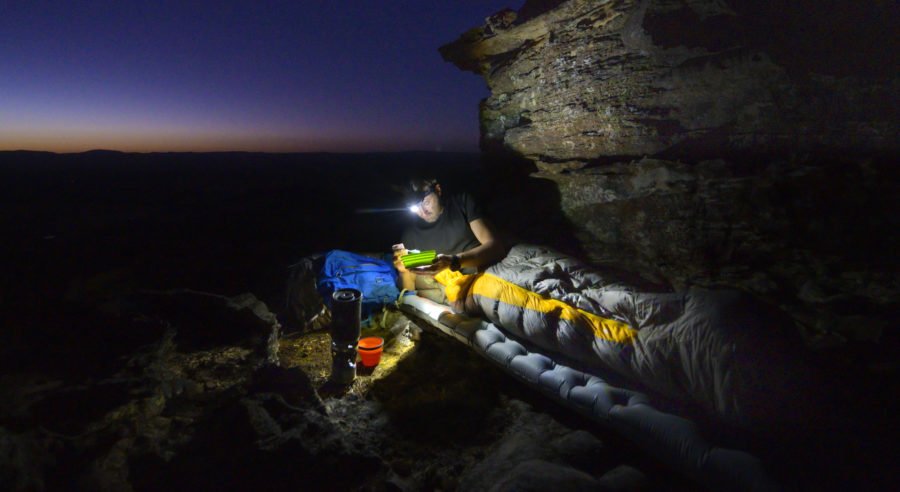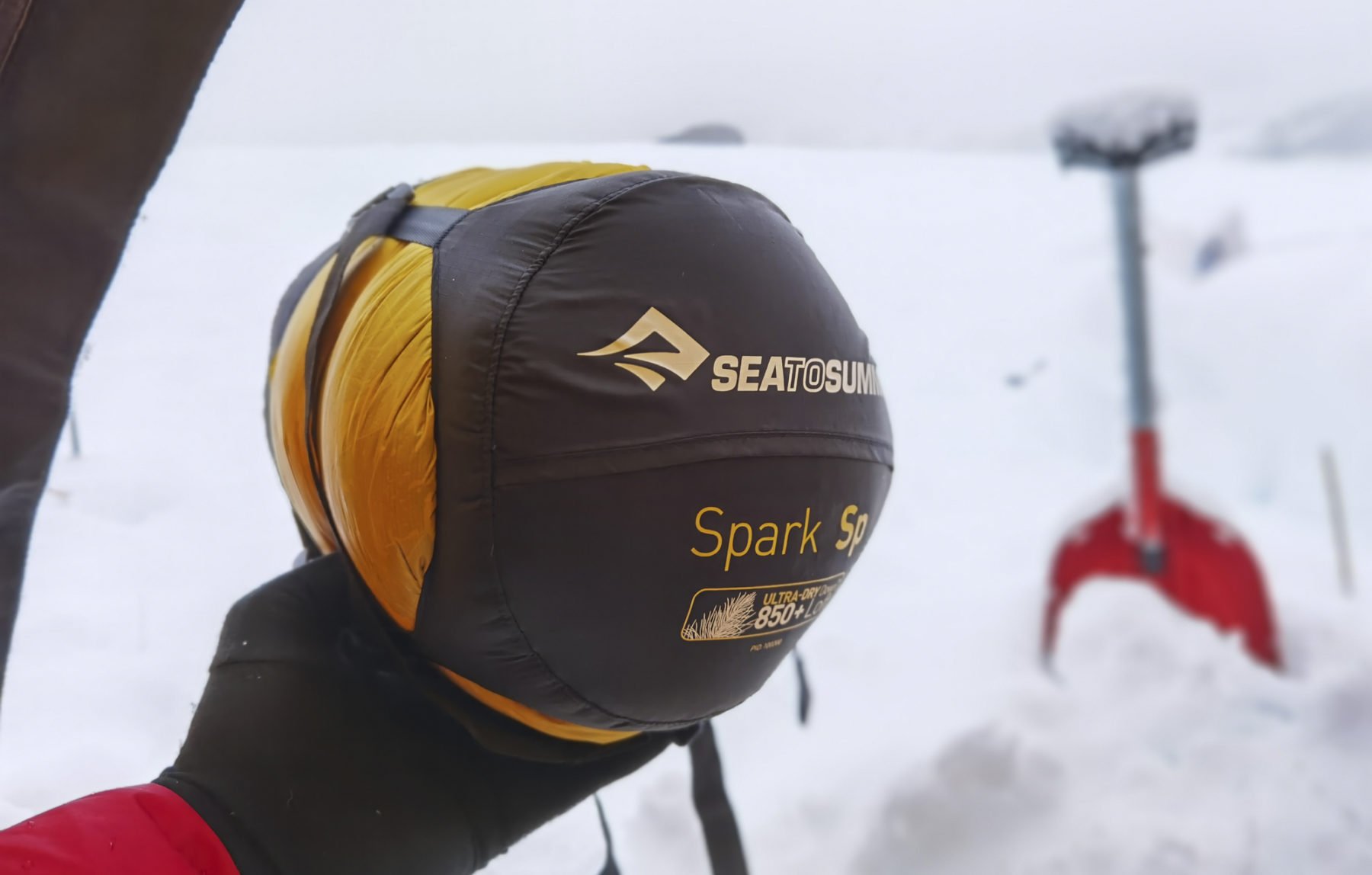Sea to Summit Sleep System: Tested

Whether it be a lockdown-induced backyard campout with kids or a remote Arctic expedition, finding the right sleep system to enable quality ‘recharge time’ can be the difference between success and failure for your chosen adventure.
The core components of a successful sleep system are a quality sleeping bag and sleeping mat. However, finding the right components for the job can be confusing, even before considering additions of liners or pillows. Fortunately, Sea to Summit has simplified the selection process with a fancy online assistant, on its website. As Aus Geo ADVENTURE’s resident ‘cold sleeper’, I was asked to test the system, starting with me, firstly, rummaging through empty energy-bar wrappers and bike tools to find a smartphone and type “Sleep System Finder”. I was intrigued to see if the code-typing tech boffins at Sea to Summit could magically create a comfy night’s sleep in even the harshest of environments.
I asked our virtual assistant for a packable system targeted at snow camping in both the Australian and New Zealand Alps. The system needed to offer the ultimate balance of super warm, super light and super packable. What we ended up with was:
1.Ether Light XT Insulated Air Sleeping Mat
2.Spark SPIV Ultralight Down Sleeping Bag (-8°C comfort rating; -15°C lower)
3.Reactor™ – THERMOLITE® Liner
4.Aeros Ultralight Pillow
Design
Balancing warmth, packability and weight is the ultimate challenge for any outdoor manufacture and while warmer sleeping bags and more packable sleeping mats exist, on the surface our “Sleep System Finder” seemed to hit the nail on the head for finding a warmth for weight compromise.
The Spark SPIV is a super lightweight sub-1kg, four-Season, 850+ Loft ULTRA-DRY Down™ sleeping bag. In layman’s terms, this is as good as it gets for sleeping bag down quality – and as minimalist as it gets for material weight. The key to the Spark IV’s usability and warmth for weight ratio lies in its materials. The Spark IV delivers 700 grams of extremely high-loft water-resistant down and uses a super lightweight 10-denier (D) 100% Nylon shell plus a mere 7D liner fabric with a super light-gauge 1/2 length YKK® zip to achieve its 985 gram weight. The ULTRA-DRY Down™ is treated with a nano-level water repellent polymer to limit any loss of insulating qualities in damp conditions where traditional down sleeping bags loose warmth.

The addition of a Reactor™ THERMOLITE® Liner boosts warmth even further. The Reactor™ 100% recycled synthetic lofting hollow-core fibre adds up to a claimed 8-degrees of warmth to our sleep system with only a 248g weight penalty. The comfortable, stretchy THERMOLITE® liner comes with a drawcord to cinch tight and compresses neatly into it’s own Ultra-Sil stuff sack. Theoretically the Spark SPIV combined with the Reactor™ THERMOLITE® liner delivers a four-season -15/-22°C (lower comfort) sleeping bag for under 1.25kg.
Sitting between sleeping bag and ground is an Ether Light XT Insulated Air Sleeping Mat. The tapered mid-weight full length three-season sleeping mat is ideal for cool climates. It is primarily an air sprung mat with 10cm-deep interconnected chambers to enable plenty of cushioning while retaining freedom of air movement. Lofting hollowcore THERMOLITE® insulation is combined with Exkin Platinum to reflect heat back to the body which in turn boost the R-value to 3.2. At 198cm x 65cm the long size mat is perfect for the taller frames. The 30/40D face fabric offers a reasonably quiet night’s sleep, especially when compared to sleeping mats of only a few years back. An inbuilt multi-valve offers super rapid inflation, or air-dumping when packing into the ultra compact 13x28cm Aerstream pump sack, which doubles as a stuff sack and inflation device.

Bonus features include pillow lock (small velcro-like tabs) to hold your pillow in place and importantly the entire unit is field repairable with self-adhesive patches or glue / patch combo. For a little luxury the 20D laminated polyester Aeros Ultralight Pillow inflates to 36cm x 26cm and 12cm of pillowy goodness. Whilst we’re quite au-fait with the ‘downie in a buff’ pillow, the Aeros inflates with a couple of breaths and sticks like glue to the Pillow Lock System and is a nice addition for a minimal weight gain of 60g in a 7.5cm x 5.5cm stuff sack.
In the field
What first hit us in the face with our sleep system was its extreme compactness and minimal weight. Our ‘long’ sized Spark IV weighed in at 911g and compressed to a tiny 18x25cm, which is exceptionally small and light for a -8 /-18°C, four-season sleeping bag. The translucent appearance of the super lightweight outer fabric was slightly disconcerting on its first foray into the Australian Alpine, but the bag performed rather well, proving the box baffle construction accompanied by zipper, hood and neck collars all perform as they should. The vertical chest baffles helped keep the down where it was supposed to be, and the The ULTRA-DRY Down™ retained its loft when condensation made everything a little damp. When we used the system in the high alpine around Mt Cook in New Zealand, we discovered a small loss of insulating abilities over a number of days when the Spark was unable to be dried, but such is the case for all down sleeping bags. The mummy deign is tried and proven to be effective at minimising heat loss by eliminating dead-air and performed well, as expected. The Spark IV’s extra volume in the chest area is meant to allow for the fitting of extra layers in extreme conditions, and once again, our New Zealand sojourn proved the design is based on real life, not just theory. The three-quarter zip eliminates the ability to ventilate from the base and can be a little awkward at first, but we quickly got used to it and loved the oversized zip-tabs. Personally, I rarely unzip a cold-climate sleeping bag beyond halfway anyway.

For those further, higher, colder expeditions, the addition of the Reactor™ – THERMOLITE® Liner is designed to boost the bags performance by up to a claimed 8°C. We’re sure it’s measurable in a lab but whilst the addition of the Reactor™ certainly made for a warmer night’s rest it didn’t feel like a -20°C alpine bag. The Reactor™, however, did its job well, boosting the bags performance for those cold nights, and cold sleepers, like me. At 198cm long, 65cm wide and weighing 625g, our Ether Light XT Insulated Air Sleeping Mat’s 10cm deep lofty baffles did their job well. The sleeping mat delivers an R-value of 3.2, thus offering a good compromise of weight to warmth. The valve technology, Airstream pump sack and Pillow Lock System are nice bonus features and work as they should, and when combined with the Aeros Ultralight Pillow it was hard to fault the entire system for general warmth and comfort.
The final word on the Sea to Summit sleep system
The tech boffins at Sea to Summit appear to have crunched their numbers correctly. We’ve used and abused their suggested sleep system for more than a year now and it performs spectacularly in cool conditions and quite well in subzero temps. Our favourite component is most definitely the super compact and quite toasty Spark IV SP Sleeping Bag. When combined with the Reactor™ liner this combo is hard to beat for such a lightweight four-season setup but I suggest the system sleeps a little colder than its claimed comfort rating. We enjoyed the luxury of the super-light Aeros and pillow lock when grams weren’t being counted and it’s an easy addition or deduction based on your activity. The Ether Light XT sleeping mat is a great all-rounder but probably the weakest link in our set-up. Whilst the mat is no slouch in the warmth for weight category, it’s hard up against competing brands like the Exped Downmat HL Winter that achieves a far superior R-Value for a similar size, and only a few grams more. In all, we are a huge fan of the Sea To Summit sleep system, however if we were asked to perfect the system for subzero alpine use we might ask for a ‘smidge’ more down in the Spark IV, and an offering of ULTRA-DRY Down™ in an Ether Light to create a super light mat of equal brilliance to the Spark technology.

Yep, the Ether Light XT sleeping mat is seriously light and tiny… 
As is the Spark SPIV sleeping bag, but it packs a warming punch.
Pricing
Ether Light XT Insulated Air Sleeping Mat: $300 (Tapered); $350 (Long)
Spark SPIV Ultralight Down Sleeping Bag: $849.00 (Regular); $899 (Long)
Reactor™ – THERMOLITE®: $90
Aeros Ultralight Pillow: $50-55

